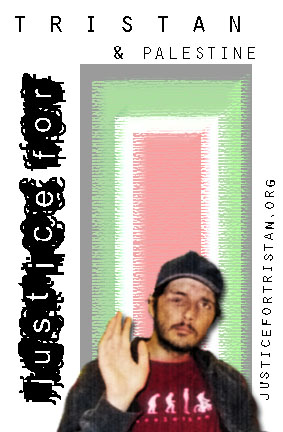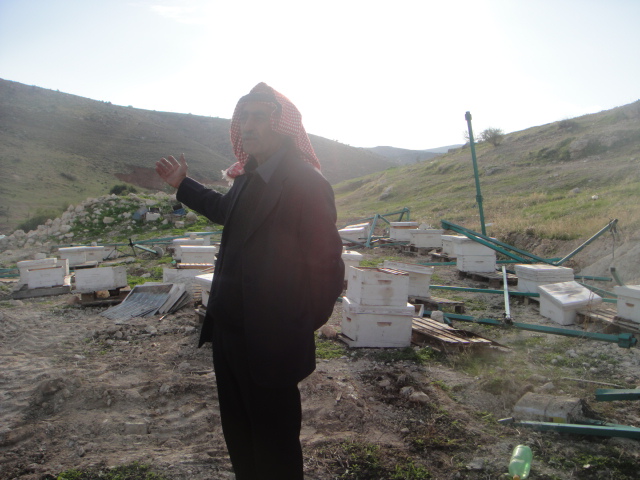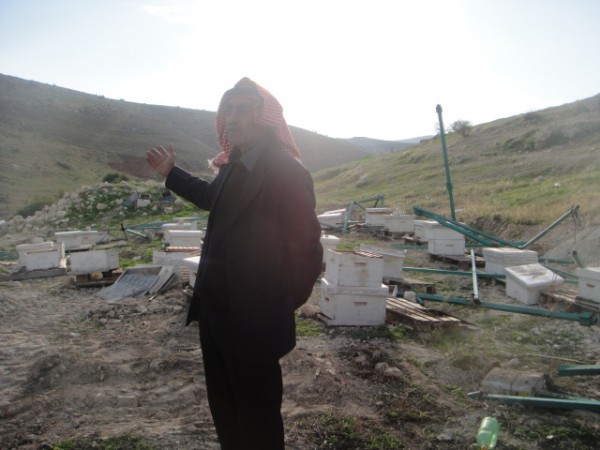by Charlotte Silver
3 Demember 2011 | The Electronic Intifada
“If he had been a Palestinian, he would have gone to the Ramallah hospital and died,” Gabby Silverman said firmly.
Silverman was close enough to Tristan Anderson that she didn’t even have to shout for him to hear her when he was shot in the head by the Israeli border police.
Anderson was 37 years old when he was shot in the right corner of his forehead by a high velocity tear gas canister that broke his skull, penetrated his right eye and devastated his frontal lobe. It was 13 March 2009, and the weekly nonviolent demonstration against Israel’s wall in the West Bank village of Nilin was coming to a close.
But Anderson did not die. He was taken to a hospital in Tel Aviv where he would be treated for the next 15 months. Silverman stayed with him, keeping close watch.
Anderson and his family have filed a civil suit against the Israeli military for the injury he sustained. Evidentiary hearings for the suit were to begin in Jerusalem in late November; however, the trial was postponed due to a last-minute revelation of material evidence.
New video evidence could lead to indictment
Lea Tsemel, an Israeli human rights lawyer who is representing Anderson in his civil suit, told The Electronic Intifada that mere days before the hearing was to begin, new video evidence emerged. “The footage, found only now, shows the army in the village the day Tristan was shot,” she said. “All of us [the state and lawyers] were surprised by the new evidence and wanted to investigate it before we go forward,” said Tsemel.
Now, before proceeding with the civil case against the army, lawyers representing Anderson in the criminal court will submit the newly discovered footage to the State Attorney’s office.
“We believe that the evidence supports the immediate re-opening of the investigation, and we hope that investigation will yield enough evidence to lead to the filing of an indictment before a criminal court,” said Emily Schaeffer, a lawyer with Michael Sfard’s Law Office, who represented Anderson and his family in the separate criminal case.
For Silverman and Anderson, the trial is not about weeding out a few bad apples, but challenging a regime that has never been held accountable.
“Palestinians die at protests all the time — no one will even talk about it. But people will talk a little about Tristan,” Silverman noted.
Long-term social justice protesters
In 2000, 17-year-old Gabby Silverman had long, thick wavy hair died bright red and wore unlaced combat boots. She was in the midst of the “A16” demonstration against theInternational Monetary Fund and World Bank in Washington, DC when Tristan Anderson first saw her.
“I walked by you and I noticed your shoes. Shoes tell you a lot about a person,” Anderson recalled in September 2011, as sat in his wheelchair in the house he shares with Silverman in Oakland, California. We were joined by their friend Ayr. Anderson’s right hand fingered the almonds in a bowl on a table. Every so often, he brought one to his mouth and ate it.
Today, Anderson is hemiplegic, almost entirely paralyzed on his left and dominant side, and blind in his right eye.
“Everyone was wearing black, but you had bright red hair and I thought, wow, look at her,” he added. Then the crowd pushed Silverman and Anderson away in different directions.
Eight years later, Anderson would meet Silverman again — this time at the top of an old oak tree at the University of California at Berkeley in the winter of 2007. They were both involved in a long-term protest of the university’s decision to cut down a grove of ninety ancient oaks to make room for a new gym.
The tree-sit lasted until September 2008 but Anderson and Silverman remained together as a couple. In March 2009, Silverman decided to travel to Palestine. She explained that as a person of Jewish background, she has been told her entire life that the country was personally relevant to her.
“I came with the intention to get a better understanding of what was going on in Israel and Palestine; I felt like I had a responsibility,” she said.
Anderson followed Silverman to the Middle East. Anderson had spent his adult life travelling Europe and the Americas, photographing what he saw and engaging with various types of international solidarity work.
Explaining his past work, Tristan told The Electronic Intifada: “Sometimes it’s solidarity, sometimes it’s like we’ve all got to fight against something. I did everything there is to do: bicycle activism, gardening activism, anti-globalization activism, [US political prisoner] Mumia [abu Jamal] activism, tree-sitting.”
Taking his lead from Silverman, Anderson decided he, too, wanted to learn more about what was happening in Palestine. He was in Palestine for six weeks before he was injured.
Anderson’s injury
Anderson’s injury initially wiped out his short-term memory. For many months, he had no recollection of events that had occurred within a year of the incident. However, with daily, arduous rehabilitation exercises he has regained some of the lost memories.
Anderson told The Electronic Intifada with certainty that he does not remember the day he was shot.
“It’s weird to think about things you have no memory of; I’m used to going through life with memories,” he said.
But glimpses of his time in Palestine have surfaced. Anderson remembers the iconic Stars and Bucks Cafe in downtown Ramallah, Silverman’s relatives in Israel and the first day he arrived in the West Bank.
“Israel tries to make [the occupied West Bank and Gaza Strip] unbearable and they’ve done that quite well,” says Tristan.
Silverman and Anderson were based in Susya in the south Hebron hills in the occupied West Bank, but would travel to Nilin every weekend to attend the demonstrations there.
Nilin is a small city near Ramallah that borders the green line, the internationally-recognized armistice line between Israel and the occupied West Bank. In 1995, after the signing of theOslo II Interim Agreement, Nilin was included in Area C, making it part of the nearly 60 percent of the West Bank which is under full civil and military control of the Israeli army. When one-third of its land was slated to be confiscated with the construction of Israel’s wall in the West Bank in 2008, the village began weekly protests.
“I watched him fall”
Alone, Silverman spoke directly with The Electronic Intifada as she sat at her kitchen table in Oakland, cutting vegetables for a pot of soup. Anderson and their friend Ayr were in another room. Her hair is still long but now is a mix of natural golden and dark brown, and a few strands of grey.
Silverman recalled, “The demonstration was winding down at the end of the day — most of the people had left — but some were still walking around. But Tristan and I walked away from the crowd to get some air from the lingering tear gas.”
This was Silverman’s fifth and Anderson’s sixth demonstration in Nilin, but she recalled still feeling like an outsider there. “People didn’t really know us,” she explained.
They recognized a fellow international activist standing with three Palestinians in the shade and joined them.
Silverman stopped chopping to walk me through the next few moments. “Tristan had wandered off with his camera. I was looking at him. And out of nowhere, they opened fire on us. The first shot they fired, they got Tristan.
“I watched him get shot, watched him fall.”
Silverman left the kitchen for a moment and returned with two empty tear gas canisters. One is about a half-a-foot-long cylinder, metallic and hollow. The other is a black, dense sphere and felt like a small bowling ball in my hand. Anderson was shot with the latter, a new high-velocity tear gas projectile that had become known as the “bad gas.”
According to Sarit Michaeli, spokesperson for Israeli human rights organization B’Tselem, this particular kind of tear gas was introduced to the West Bank in the midst of Operation Cast Lead, Israel’s attack on Gaza in the winter of 2008-09.
The canister that hit Anderson is called “extended range tear gas” and is made by the United States-based company Combined Systems, Inc, which makes “non-lethal” and “less-lethal” weapons. The company’s website recommends using the type of tear gas that hit Anderson to break barriers.
What makes this weapon particularly dangerous is that it has an internal mechanism that propels it forward, significantly increasing its impact. “It’s like firing a small missile,” Michaeli explained.
One month after Tristan was shot, the very same device would kill Bassem Abu Rahmeduring a demonstration in the nearby village Bilin.
According to eyewitness testimony collected by B’Tselem, the canister was shot directly at Anderson from a hilltop around 60 meters away. The tear gas projectile has a range of 250 meters.
Michaeli told The Electronic Intifada that the investigation conducted by Israeli police in the West Bank revealed that there were three groups of border police deployed throughout Nilin on 13 March, the day Anderson was shot. The investigation confirmed eyewitness statements given to B’Tselem — that there was indeed a group stationed on a hill approximately 60 meters away from where Anderson was standing.
However, that team of border police was never investigated.
“It was a careless investigation. It cannot be described as thorough, professional or complete,” said Schaeffer, in a statement mailed to The Electronic Intifada.
“Unfortunately the authorities’ treatment of Tristan’s case is not the exception — in my office alone we have seen literally hundreds of cases of Palestinians injured by the security forces whose investigations have also been negligent and have therefore failed to hold anyone accountable,” Schaeffer added.
According to statistics gathered by Palestinian human rights organization Al Haq, 57 Palestinians have been killed at demonstrations in the West Bank and Gaza Strip since the second intifada began in September 2000.
In June 2009, Akil Srour, 36, who was with Anderson at the time he was shot, was killed in Nilin when soldiers shot live-ammunition into the crowd. Srour was the fifth Palestinian to be killed in Nilin during an 18-month period.
Anderson’s recovery
For the three months after his injury, Silverman slept in the same room as Anderson as he moved from the intensive care unit to rehabilitation in a Tel Aviv hospital. Shortly after he was shot, Anderson’s parents arrived in Tel Aviv to be with their son.
Throughout the next 15 months, Anderson’s health was precarious and fluctuated wildly. The various viruses, diseases and infections Anderson picked up rolled off Silverman’s tongue like a grocery list during our interview.
“The doctors would tell me that he’s in a ‘dynamic’ state — meaning at any point he could die,” Silverman said bluntly.
She explained that initially Anderson was all but comatose. Doctors told her that they eventually hoped “for some kind of meaningful communication,” which Silverman translated to mean that he would be able to answer yes or no questions.
As Anderson gained lucidity while in the Tel Aviv hospital, the extent of the injury to his brain emerged. Typical of frontal lobe injuries, he had initially lost his short-term memory, and had a hard time learning new things. “He had to relearn how to swallow, he had developed dysphasia [impairment of the ability to communicate]. We worked for hours every day. But now he can eat anything he wants,” Silverman said.
To this day, his impulse control is compromised. Silverman said that Anderson is easily distracted by shiny cars or big advertisements, and cannot be trusted around streets.
He also does not believe that he is blind in his right eye.
“It’s very difficult to interact with someone who doesn’t respond to reason,” Silverman added.
With some caution, she said, “Luckily for us, Tristan is still continuing to improve.”
While he has recovered well beyond the hope of the initial prognosis, he requires constant assistance. These days, Anderson stays with his parents in Grass Valley, a small town in northern California, and comes down to Oakland to be with Silverman and other friends on the weekends.
“Akil was killed, Bassem is dead. The Tristan that I knew — who was my partner — who we all knew — he doesn’t exist anymore.”
Silverman added, “They [Palestinians] won’t get a big trial. That is why we have a responsibility to go through with this.”
With the new evidence, the State Attorney’s office will now decide whether to re-open the investigation, thereby opening the possibility for Anderson and his family to pursue criminal charges against the Israeli military.
Charlotte Silver is a journalist based in the West Bank. She can be reached at charlottesilver A T gmail D O T com.








